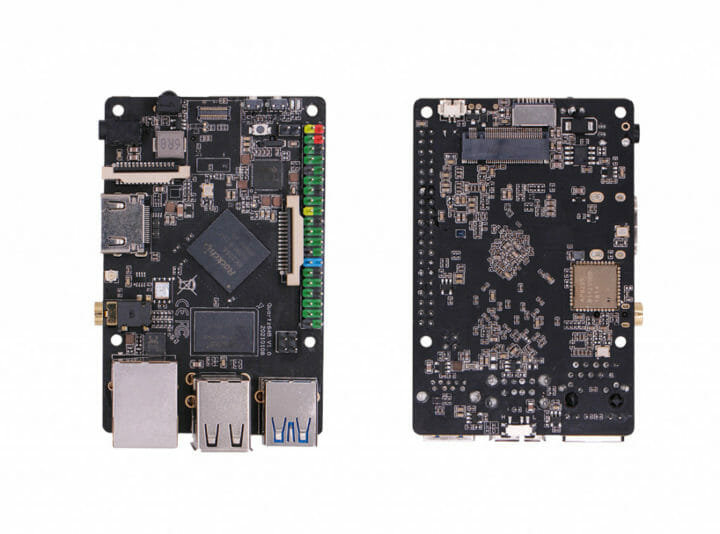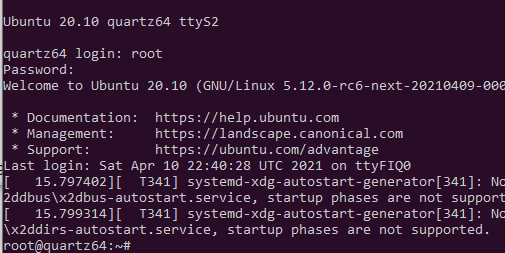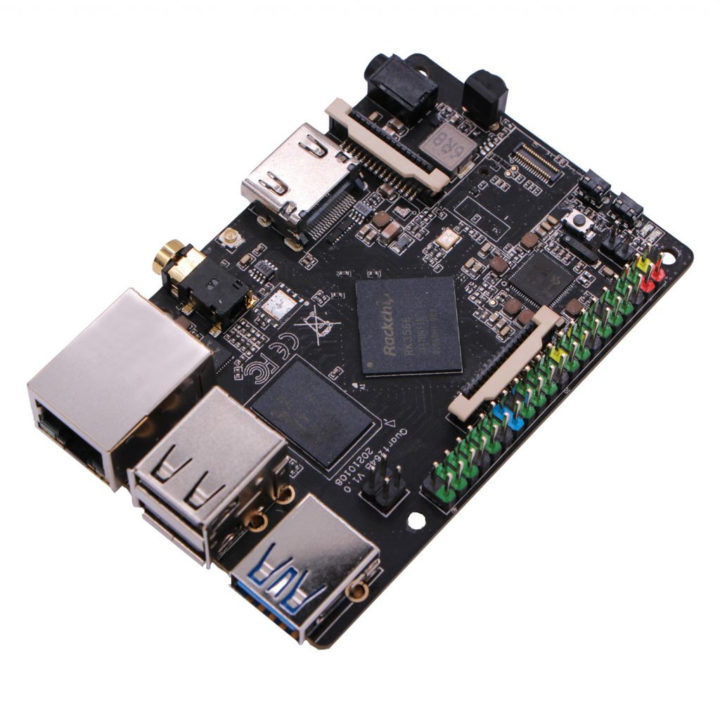Pine64 unveiled the Quartz64 SBC powered by Rockchip RK3566 processor a few months ago. More specifically they provided details about Quartz64 Model A at the time, a featured-rich variant with SATA, PCIe, multiple display outputs, etc…
During the announcement, Pine64 also indicated a Raspberry Pi-sized Quartz Model B was in the works but did not have a prototype to showcase just yet. In the latest Pine64 April update, the community showcased the new board, reported software progress, and information about production delays for Model A.
Quartz64 Model B
- SoC – Rockchip RK3566 quad-core Cortex-A55 processor up to 1.8 GHz with Arm Mali-G52 GPU supporting OpenGL ES 1.1/2.0/3.2, OpenCL 2.0, Vulkan 1.1, 0.8 TOPS NPU for AI acceleration
- System Memory – 2GB to 8GB LPDDR4
- Storage
- 128 Mbit SPI Flash
- optional eMMC module from 16GB up to 128GB capacity
- bootable SDHC/SDXC MicroSD card up to 2TB
- Video Output / Display Interfaces
- HDMI 2.0a up to 4Kp60
- 2-lane MIPI DSI up to 1080p
- Camera I/F – 2-lane MIPI CSI camera Interface up to 5MP
- Audio – 3.5mm audio jack
- Networking
- 10/100/1000Mbps Gigabit Ethernet RJ45 port
- WiFi & Bluetooth via
either a Realtek Bluetooth/WiFi chipset orBouffalo BL602 module(Note: two models of the board will be provided)
- USB – 2x USB 2.0 host ports, 1xUSB 3.0 host port
- Expansion
- 40-pin GPIO header
- M.2 PCIe socket
- Misc – RTC battery connector, IR Tx/Rx
- Power Supply – 5V/3A DC input via 3.5/1.35mm DC barrel jack
- Dimensions – 85 x 56 x 18.8mm
 Besides the features that can be removed such as the PCIe x4 slot, eDP interface, etc.., some other changes include support for 2-lane MIPI CSI & DSI interface instead of 4-lane on the Model A board, WiFi is no longer optional an integrated into the board via
Besides the features that can be removed such as the PCIe x4 slot, eDP interface, etc.., some other changes include support for 2-lane MIPI CSI & DSI interface instead of 4-lane on the Model A board, WiFi is no longer optional an integrated into the board via either a Realtek or an BL602 module [Update: BL602 has now been confirmed to be the only option], and an M.2 PCIe socket has been added. The power supply is also different with 5V input on Model B, instead of 12V on Model A. Pine64 had the good idea of using different DC jack sizes so you don’t need to fry your Model B board with a power adapter for model A.
Production delays
We’ve already written about recent chips shortages, lead times of up to 52 weeks, so it should come as no surprise that Quartz64 Model A production has also been affected. Pine64 explains this is due to the lack of stock of the Gigabit Ethernet PHY (namely RTL8211F-CG based on the schematics), with a projected lead time of 12 months, and a price increase of 850%, yes, that’s eight hundred fifty percent.
So the decision has been made to use a separate PHY, meaning Quartz64 Model A production is expected to be pushed back by a month or more, and probably occur at the same time as the B model. But of course, it’s very difficult to make predictions in this environment
Software Progress
While there is bad news on the manufacturing side, software development is progressing nicely. Yesterday, we reported mainline Linux support for Rockchip RK3566/RK3568 processors should happen pretty soon, and Pine64 confirms the board can now boot both mainline and BSP Linux.

With Linux 4.19 from Rockchip BSP, Quartz64 can boot into userspace with Gigabit Ethernet, USB 2.0, and serial working, albeit with some limitations for the latter two, as USB is unstable with long cables and serial requires FIQ-Debugger. Mainlinux Linux is said to have already implemented clocks, GPIO, micro SD, eMMC, USB 2.0, USB 3.0, and the GbE controller.
But there’s still a lot of work as for instance USB 3.0 and PCIe cards are not working, and little things like rebooting the board are not functional at this stage. That means it will take a while for Linux to be used on Quartz64 and other RK356x boards, and at launch, it’s likely only Android 11 will be useable by end-users.

Jean-Luc started CNX Software in 2010 as a part-time endeavor, before quitting his job as a software engineering manager, and starting to write daily news, and reviews full time later in 2011.
Support CNX Software! Donate via cryptocurrencies, become a Patron on Patreon, or purchase goods on Amazon or Aliexpress. We also use affiliate links in articles to earn commissions if you make a purchase after clicking on those links.






Not a good time for some silicon. Fire at Renesa plant, water shortage in Taiwan, Broadcom modem chips over a year waiting times and coin miners making graphics card high price.
Do you like this?
If I only own the Model B, I’d prefer 5.5/2.1mm, but if I own a bunch of Model A and Model B, it’s nice to have different sizes as they use different supply voltages.
Here is a helpful flow chart:
1) Is your device primarily battery powered? If yes, use USB-C.
2) Is your device targeted at customers who will buy QTY 0 – 1? If yes, use USB-C because these people want to re-use their existing charger and cable and will not be dedicating a power supply for 24/7 operation since they will need to also charge their phone.
3) If none or the above apply, use a barrel connector for power.
BONUS:
1) Is your device targeted at customers who will buy QTY 0 – 1? If yes, use a bottom mounted heatsink.
2) If the above does not apply, use a top mounted heatsink.
#YourWelcomeInternet
Feel free to leave flamez in the comments below.
Can you ammend the bonus section to “1) Is your device targeted at customers who will buy QTY >0? If yes, use a bottom mounted heatsink. 2) Never use a top mounted heatsink.”
N2/N2+ FTW.
Take the RockPi 4 as an example. It has a RPi form factor, yet it will never fit in any RPi case because of its bottom heat sink. The heat sink is proprietary, sold separately, and represents an additional 13% cost (based on SeedStudio pricing).
When purchasing a single unit, the above can be overlooked. However, when purchasing 1000+ units, its a different story.
It has been my experience that bottom mounted heat sinks add a significant amount of additional cost, weight, and complexity to any project using them. They are far more suited to the customer who will only purchase a single unit.
Whereas top mounted heatsinks are often an afterthought and poorly glued on messes which have strange shapes or mountings as there are other devices to get in the way–wifi antennas, tall inductors, etc. The only top mounted heatsinks I’ve seen are the ODROID-Cx family where it was clearly designed in from the beginning.
I have no love for the RPi form factor and your arguement that a bottom mounted heatsink won’t let that board fit an RPi case carries little weight with me. The right solution would be to design the bottom of the case to be the heatsink–look at the beautiful designs of Mr. Honey at https://cogent.design/ They’re beautiful and functional–and another reason I don’t like seeing WiFi and BT on a PCB with no external antenna connector.
If you design a board that needs a heatsink (but are too lasy to design it with a heatsink), at least provide an antenna connector for the radios so that competent people can make use of it.
If you’re doing 1000+ units, use a board that comes with a functional case. You can’t stuff an Rpi in a tight case with some stick on heatsinks and expect it to do anything but throttle in its own stench.
This increases the cost from an additional 13% to an additional 49% based on prices listed. Again, fine for QTY 1 purchase.
Quartz64 is meant as a drop-in replacement / upgrade for both Rock64 and Pine-H64 (B). As such keeping the same power connector makes a lot of sense. Pine’s PSU with this connector is a solid one and adapters are just a simple web search for ‘3.5/1.35 5.5/2.1’ away 😉
No, that’s a bad decision. Yay for barrel jack, boo for 5V (straight to USB) meaning upstream is responsible to voltage regulation. Much prefer the Odroid-C4’s 5.5mmx2.5mm (5.5V to 13V). Or better yet the N2+’s 7.5V to 18V on the same standard jack. This allows a C4, N2+ to share a large 12V distribution system.
Summary: Barrel jacks are better than USB and on board regulation of USB is better than supply regulation.
…would an adapter cable allow me to use the “M.2 PCIe socket” for a 1X PCIe Graphic card? Which cable could fit?
In the past I would’ve recommended to use the search bar in the upper right corner and enter there ‘pcie aperture bar’ to get an idea why most likely no GPU will work with Rockchip’s PCIe implementation. But since this blog implemented this up-/downvoting crap and is now mostly focused on RPi add-ons/enclosures the search is broken too.
It looks like the Search function would not look into comments anymore. I’ve added a plugin to handle that, and disabled the voting system as well.
+1
thx && upvote+=1 😉
But the voting system is how we detect that the rpi boys have been through. If Thomas and I aren’t voted down, do we really know they were here?
Usually some of them can’t resist the temptation to post tons of non-sense and are easily identified 🙂
If I can’t be upvoted on the internet, do I even exist ?!?
Was it you or your post which was upvoted ? Maybe only your posts exist and you don’t exist. That leaves the question of who’s posting your messages then. 🙂